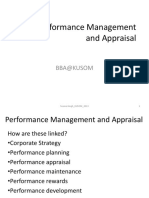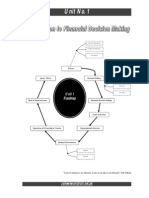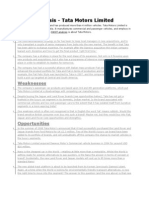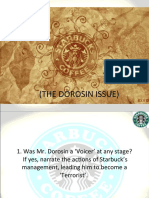0 ratings0% found this document useful (0 votes)
85 viewsCase Study Analysis
Case Study Analysis
Uploaded by
anupama8This document provides a framework for conducting a case study analysis. It outlines 8 key steps: 1) analyze the company's history, development and growth, 2) identify internal strengths and weaknesses, 3) analyze external opportunities and threats using Porter's five forces model and life cycle model, 4) evaluate the SWOT analysis using a TOWS matrix, 5) analyze corporate strategy, 6) analyze business level strategy, 7) analyze organizational structure and control systems, and 8) make recommendations. It also discusses the importance of financial analysis and ratios, and provides guidance on writing the case study analysis.
Copyright:
© All Rights Reserved
Available Formats
Download as DOC, PDF, TXT or read online from Scribd
Case Study Analysis
Case Study Analysis
Uploaded by
anupama80 ratings0% found this document useful (0 votes)
85 views4 pagesThis document provides a framework for conducting a case study analysis. It outlines 8 key steps: 1) analyze the company's history, development and growth, 2) identify internal strengths and weaknesses, 3) analyze external opportunities and threats using Porter's five forces model and life cycle model, 4) evaluate the SWOT analysis using a TOWS matrix, 5) analyze corporate strategy, 6) analyze business level strategy, 7) analyze organizational structure and control systems, and 8) make recommendations. It also discusses the importance of financial analysis and ratios, and provides guidance on writing the case study analysis.
Original Description:
Case Study Analysis
Original Title
Case+Study+Analysis
Copyright
© © All Rights Reserved
Available Formats
DOC, PDF, TXT or read online from Scribd
Share this document
Did you find this document useful?
Is this content inappropriate?
This document provides a framework for conducting a case study analysis. It outlines 8 key steps: 1) analyze the company's history, development and growth, 2) identify internal strengths and weaknesses, 3) analyze external opportunities and threats using Porter's five forces model and life cycle model, 4) evaluate the SWOT analysis using a TOWS matrix, 5) analyze corporate strategy, 6) analyze business level strategy, 7) analyze organizational structure and control systems, and 8) make recommendations. It also discusses the importance of financial analysis and ratios, and provides guidance on writing the case study analysis.
Copyright:
© All Rights Reserved
Available Formats
Download as DOC, PDF, TXT or read online from Scribd
Download as doc, pdf, or txt
0 ratings0% found this document useful (0 votes)
85 views4 pagesCase Study Analysis
Case Study Analysis
Uploaded by
anupama8This document provides a framework for conducting a case study analysis. It outlines 8 key steps: 1) analyze the company's history, development and growth, 2) identify internal strengths and weaknesses, 3) analyze external opportunities and threats using Porter's five forces model and life cycle model, 4) evaluate the SWOT analysis using a TOWS matrix, 5) analyze corporate strategy, 6) analyze business level strategy, 7) analyze organizational structure and control systems, and 8) make recommendations. It also discusses the importance of financial analysis and ratios, and provides guidance on writing the case study analysis.
Copyright:
© All Rights Reserved
Available Formats
Download as DOC, PDF, TXT or read online from Scribd
Download as doc, pdf, or txt
You are on page 1of 4
At a glance
Powered by AI
The key takeaways are the steps involved in analyzing a case study which includes analyzing the company's history, identifying internal and external factors, evaluating SWOT analysis, analyzing corporate and business level strategies, and making recommendations.
The steps involved in analyzing a case study are: 1) Analyze company history, 2) Identify internal strengths and weaknesses, 3) Analyze external environment, 4) Evaluate SWOT analysis, 5) Analyze corporate level strategy, 6) Analyze business level strategy, 7) Analyze structure and control systems, and 8) Make recommendations.
The financial ratios discussed for analyzing a company are profit ratios, liquidity ratios, activity ratios, leverage ratios, and shareholder return ratios.
Case Study Analysis
C-1 What is Case Study Analysis
An account of what happened to a business or industry over a number of years
In our course the use of strategic management techniques are paramount
Case Study Prep slides
C-2 Analyzing a Case Study
This framework is a guide, not a hard and fast rulebook. Your chair may
recommend emphasizing or deemphasizing various parts of this framework.
1-Analyze the companys history, development, and growth
Limit this section of your paper to three paragraphs; the first on history, the
second on development, and the third on growth. You should also identify a
problem statement at this point. Be sure to keep the problem statement simple
and to the point. This will be Part A.
2-Identify the companys internal strengths and weaknesses.
Start to develop a SWOT table here. Identify 5 or 6 strengths and weaknesses,
and then discuss the two or three most important of them in narrative form. This
will form part of Part B.
3-Analyze the external environment (opportunities and threats).
Of particular importance at the industry level are Porters five forces model and
the life cycle model.
Use these two models to analyze the external environment
Finish the SWOT table here. From the models mentioned above identify 5 or 6
opportunities and threats and then discuss the two or three most important of them
in narrative form. This will form part of Part B.
4-Evaluate the SWOT analysis.
Your TOWS matrix comes together here. Be sure to take a good look at the
sample provided here and model yours after this one. Use strengths to generate
opportunities and avoid threats, overcome weaknesses to take advantage of
opportunities and minimize threats. This will form part of Part C.
5-Analyze corporate level strategy
Go to the organizations Web site or annual report and define the mission and
goals.
Most of the time you will find these, although there may be a chance that you will
have to infer them from the case or other available information
Using your SWOT analysis, TOWS matrix and the corporate mission, identify
three viable alternatives and debate the merits of each. Remember, do nothing
is always a viable strategy, although many times inappropriate. This will be part
of Part C.
6-Analyze business level strategy
Each business the organization is in will have its own business level strategy
Identify the organizations generic competitive strategy differentiation, low cost,
focus and its investment strategy
Identify functional strategies used to achieve competitive strategy through
superior efficiency, quality, innovation, and customer responsiveness in order to
achieve its business level strategy
This section will be used to see if the alternatives can be implemented using
current strategy or if new strategies will need to be developed.
7-Analyze structure and control systems
The organizational structure of the organization vertical or horizontal
differentiation, product or functional structure
Organizational conflict, power and politics
This section will be used to see if the alternatives can be implemented using
current organization and structure or if the organization will have to change its
structure or control systems.
8-Make recommendations
Make sure your recommendations are consistent and written in the form of an
action plan.
Choose one of your three alternatives and justify your choice. You should use a
decision criteria matrix to help with your decision. If major changes in strategy,
structure or control systems need to be implemented you must describe that at this
point. This is part of your Part D.
C-3 The Role of Financial Analysis in Case Study Analysis
Choose one ratio from each group and calculate those ratios for a 3-5 year time
period, and then analyze the ratios. Remember, there are people who will be
reading your paper who have absolutely no idea what a current ratio of 1.2 means!
It never hurts to be able to identify the industry average or the numbers for the
principal competitor(s) as well, if available (then obviously use a shorter time
frame than 3-5 years). Ratios become part of your Part B.
Financial Performance Ratios
o Profit Ratios
Return on Invested Capital
Profit earned on capital invested in the company.
Return on Total Assets
Profit earned on the employment of assets.
Return on Stockholders Equity
The percentage of profit earned on common stockholders
investment in the company.
o Liquidity Ratios
Current Ratio
The extent to which the claims of short term creditors are
covered by assets that can be quickly converted to cash
Quick Ratio
The ability to pay off the claims of short term creditors
without having to sell inventory.
o Activity Ratios
Inventory Turnover
Useful in determining if the company is carrying excess
inventory.
Days Sales Outstanding or Average Collection Period
The average time a company has to wait in order to receive
cash after a sale.
o Leverage Ratios
Debt to Assets Ratio
The extent to which borrowed funds have been used to
finance a companys investments.
Debt to Equity Ratio
The balance between debt and equity in a companys
capital structure
Times-Covered Ratio
The extent to which a companys profits covers its annual
interest payments.
o Shareholder Return Ratios
Total Shareholder Returns
Shareholder returns earned by time t+1 on an investment
made at time t.
Price Earnings Ratio
The amount investors are willing top ay per dollar of profit.
Market to Book Value
The companys expected future growth prospects.
Dividend Yield
The return shareholders received in the form of dividends.
Cash Flow
o Cash received less cash distributed
Positive cash flow means money for future expansion
Companies in mature industries frequently have very strong
cash flow positions.
High growth may lead to a poor cash flow position
Companies in strong growth industries are frequently in
poor cash flow positions
C-4 Writing a Case Study Analysis
When you have successfully completed your Outlines A through D you are ready
to start writing your case.
Follow this Final Paper Format in writing your paper.
o Do not repeat large pieces of factual information from the case
o Make sure the sections and subsections flow logically and smoothly.
o Avoid grammatical and spelling errors
o Reference List for Locating Information on Companies
C-5 Be systematic! Make sure you are consistent in your analysis.
You might also like
- Persimmon PLC: A Valuation Based Financial AnalysisDocument14 pagesPersimmon PLC: A Valuation Based Financial AnalysisUsmanNo ratings yet
- “Section 172 of the Companies Act 2006 is nothing more than statutory ‘window dressing’. It adds nothing at all of substance to the director’s traditional fiduciary duty of loyalty. It is also confusing and creates unnecessary uncertainty for directors with regard to their legal liability risk.”Document9 pages“Section 172 of the Companies Act 2006 is nothing more than statutory ‘window dressing’. It adds nothing at all of substance to the director’s traditional fiduciary duty of loyalty. It is also confusing and creates unnecessary uncertainty for directors with regard to their legal liability risk.”Malcolm Ong Jian Ming100% (1)
- Assignment 2 - Capital Investment AppraisalDocument20 pagesAssignment 2 - Capital Investment AppraisalChazNo ratings yet
- IMC Final Exam Revision Questions STUDENT VERSIONDocument8 pagesIMC Final Exam Revision Questions STUDENT VERSIONmonika sharmaNo ratings yet
- Case Study Group 3.2Document17 pagesCase Study Group 3.2Karl Pepon Ayala100% (1)
- Equity Research Financial ModelingDocument6 pagesEquity Research Financial Modelingdevansh raghuwanshiNo ratings yet
- MRK - Spring 2023 - COMI619 - 5 - MC210401667Document28 pagesMRK - Spring 2023 - COMI619 - 5 - MC210401667MuhammadSaadAhmadNo ratings yet
- BBA Performance ManagementDocument16 pagesBBA Performance Managementnavin9849No ratings yet
- Case Study Analysis TemplateDocument4 pagesCase Study Analysis TemplateBlessie Ysavyll SaballeNo ratings yet
- Case Study #7: Gillette 27 July 2013 Case Analysis Prepared by Group #5Document7 pagesCase Study #7: Gillette 27 July 2013 Case Analysis Prepared by Group #5Liz EspinosaNo ratings yet
- Business Plan ContentDocument3 pagesBusiness Plan ContentErmias DejeneNo ratings yet
- Where Financial Report Still Falls ShortDocument2 pagesWhere Financial Report Still Falls ShortJoel Swapnil SinghNo ratings yet
- Assignment # 3 Difference Between Financial and Strategic ObjectivesDocument5 pagesAssignment # 3 Difference Between Financial and Strategic ObjectivesFaisal AwanNo ratings yet
- Introduction of Corporate Governance: VisionDocument5 pagesIntroduction of Corporate Governance: VisionVenu VijayNo ratings yet
- FSA 19-21 Group Assignment Expectations Phase-IDocument2 pagesFSA 19-21 Group Assignment Expectations Phase-IAnishaSapraNo ratings yet
- Corporate Governance AssignmentDocument21 pagesCorporate Governance AssignmentAdasa EdwardsNo ratings yet
- HoferDocument17 pagesHoferTanya ChaudharyNo ratings yet
- Entreprenuership AssignmentDocument15 pagesEntreprenuership AssignmentBhavyata VermaNo ratings yet
- City ClubDocument17 pagesCity ClubSilviu ColeaNo ratings yet
- Motivation Strategies in Current ScenarioDocument3 pagesMotivation Strategies in Current Scenariokeerthika12311100% (1)
- Interbrand MethodologiesDocument3 pagesInterbrand MethodologiesMidhun ManoharNo ratings yet
- Memorandum 2Document4 pagesMemorandum 2Catie MaasNo ratings yet
- Unit 1 Introduction To FDMDocument12 pagesUnit 1 Introduction To FDMZaheer Ahmed SwatiNo ratings yet
- New Microsoft Word DocumentDocument3 pagesNew Microsoft Word Documentishagoyal595160100% (1)
- Case 14 2Document23 pagesCase 14 2DươngNo ratings yet
- Lesson 15 STPDocument24 pagesLesson 15 STPdjokouwm100% (1)
- HDFC Bank Project On CRMDocument70 pagesHDFC Bank Project On CRMfurqAnNo ratings yet
- Etypes Which Design Capstone ProjectDocument7 pagesEtypes Which Design Capstone ProjectAlina100% (1)
- Chapter One Introduction To Financial Modeling and Valuation ModifiedDocument21 pagesChapter One Introduction To Financial Modeling and Valuation Modifiedjoka ethio artNo ratings yet
- Marketing Segmentation - KotlerDocument23 pagesMarketing Segmentation - KotlerRajiv MondalNo ratings yet
- Downloadable Solution Manual For Essentials of Marketing Research A Hands On Orientation 1st Edition Malhotra Case 1.1 Dell 1Document21 pagesDownloadable Solution Manual For Essentials of Marketing Research A Hands On Orientation 1st Edition Malhotra Case 1.1 Dell 1dolly-sharmaNo ratings yet
- Analysing The Complexities of Pepsico'S Operations in The Global EnvironmentDocument54 pagesAnalysing The Complexities of Pepsico'S Operations in The Global EnvironmentMuhammad Mikhail K . PNo ratings yet
- PM Quiz 6Document7 pagesPM Quiz 6Daniyal NasirNo ratings yet
- BIF ChecklistDocument7 pagesBIF ChecklistMayank UpadhyayNo ratings yet
- KPMG GRP 1Document47 pagesKPMG GRP 1Onkar ShindeNo ratings yet
- 20mia1126 Da 1Document4 pages20mia1126 Da 1Chenchu AravindNo ratings yet
- Ratio AnalysisDocument33 pagesRatio AnalysisJhagantini PalaniveluNo ratings yet
- Padhy Leather - Team 6 - Case Study 2 Submission-2Document17 pagesPadhy Leather - Team 6 - Case Study 2 Submission-2ElvisNo ratings yet
- Strategic ManagementDocument4 pagesStrategic ManagementA CNo ratings yet
- Sun Silk Brand AuditDocument49 pagesSun Silk Brand AuditinkLLL0% (1)
- RM FINAL PROJECT PDF Kanika New 2023Document81 pagesRM FINAL PROJECT PDF Kanika New 2023Rishi chaurasiaNo ratings yet
- A Best ChinaDocument435 pagesA Best ChinaDataGroup Retailer Analysis100% (1)
- Kia Motors - Porters Value Chain AnalysisDocument3 pagesKia Motors - Porters Value Chain AnalysisVISHNUVARDHAN KRISHNAKUMARNo ratings yet
- Management 595 - Fall 2019 Exam 1 Study Guide: A. Essay QuestionsDocument8 pagesManagement 595 - Fall 2019 Exam 1 Study Guide: A. Essay QuestionsmeghanNo ratings yet
- SWOT AnalysisDocument6 pagesSWOT Analysisbhavesh1712No ratings yet
- Explain Apple's Success Over The Last Decade. Think About Which Industries It Has Disrupted and How. Also Look at Apple's Main CompetitorsDocument5 pagesExplain Apple's Success Over The Last Decade. Think About Which Industries It Has Disrupted and How. Also Look at Apple's Main CompetitorsPui YanNo ratings yet
- Homeplus: Riding The Korean Retailing Rollercoaster Problem StatementDocument7 pagesHomeplus: Riding The Korean Retailing Rollercoaster Problem StatementAustin Grace WeeNo ratings yet
- Human Resource Planning by TCSDocument14 pagesHuman Resource Planning by TCSPramit MandalNo ratings yet
- RCF Ratio AnlysisDocument46 pagesRCF Ratio AnlysisAnil KoliNo ratings yet
- Starbucks Case StudyDocument27 pagesStarbucks Case StudyPardeep KapilNo ratings yet
- Hide SignDocument7 pagesHide SignUmang ThakerNo ratings yet
- Becton Dickinson Corporate StrategyDocument2 pagesBecton Dickinson Corporate StrategySonu Avinash Singh0% (1)
- Coca Cola 2009 Case StudyDocument29 pagesCoca Cola 2009 Case StudyfahdtNo ratings yet
- Assignment (PMK1) - Philips Air Purifier CaseDocument5 pagesAssignment (PMK1) - Philips Air Purifier CaseSoham BanerjeeNo ratings yet
- Inter and Intra Firm Comparision & Payout RatioDocument6 pagesInter and Intra Firm Comparision & Payout RatioKumar RajeshNo ratings yet
- Segment AnalysisDocument53 pagesSegment AnalysisamanNo ratings yet
- MM Ansoff & BCG MatrixDocument31 pagesMM Ansoff & BCG MatrixAshirbad NayakNo ratings yet
- Accounting Concepts and ConventionsDocument19 pagesAccounting Concepts and ConventionsSuksham AnejaNo ratings yet
- Objectives of The Dividend PolicyDocument2 pagesObjectives of The Dividend Policy2801 Dewan Foysal HaqueNo ratings yet
- Company Compliances For StartupsDocument6 pagesCompany Compliances For StartupsKrishnendu BhattacharyyaNo ratings yet
- Value Chain Management Capability A Complete Guide - 2020 EditionFrom EverandValue Chain Management Capability A Complete Guide - 2020 EditionNo ratings yet
- Business Finance FormulaDocument9 pagesBusiness Finance FormulaGeorge Nicole BaybayanNo ratings yet
- Chapter 9 PracticeDocument4 pagesChapter 9 Practicexabir54952No ratings yet
- Ratio Analysis of M&M and Eicher MotorsDocument16 pagesRatio Analysis of M&M and Eicher MotorsGs AbhilashNo ratings yet
- Soal Latihan 2Document4 pagesSoal Latihan 2Fradila Ayu NabilaNo ratings yet
- PraxisIFM Group LTDDocument51 pagesPraxisIFM Group LTDAmer MohdNo ratings yet
- Oriental Engineering Works PVTDocument20 pagesOriental Engineering Works PVTDarshan DhimanNo ratings yet
- Eligibility Norms For IpoDocument2 pagesEligibility Norms For IpoParth PatelNo ratings yet
- 2023 04 13 Leak Announcement Microsite UploadDocument5 pages2023 04 13 Leak Announcement Microsite UploadstevenjohnhNo ratings yet
- Bolton's Reading ListDocument2 pagesBolton's Reading ListTrong NguyenNo ratings yet
- Kingdom Bank AlliancesDocument17 pagesKingdom Bank AlliancesFarai Gillie Gudo100% (1)
- RKF Release Letter - DSK03072019Document3 pagesRKF Release Letter - DSK03072019Mufti Abdul SohailNo ratings yet
- Chapter 14Document59 pagesChapter 14mas aziz100% (1)
- Solutions 1Document5 pagesSolutions 1Angeliki ChasikouNo ratings yet
- IPOsDocument16 pagesIPOsZahid BashirNo ratings yet
- Aditya Birla Capital Policy On Materiailty of InformationDocument6 pagesAditya Birla Capital Policy On Materiailty of InformationJenish patelNo ratings yet
- Accounting Basics:: Choose The Right AlternativeDocument6 pagesAccounting Basics:: Choose The Right AlternativeOlfa FATNASSINo ratings yet
- Brambles 1Document15 pagesBrambles 1hotshot2004No ratings yet
- HDFC Bank: Project Report OnDocument99 pagesHDFC Bank: Project Report OnSubhash SinghNo ratings yet
- Corporate Financing Decision (MFIN 641) Mba V Term Kathmandu University School of ManagementDocument42 pagesCorporate Financing Decision (MFIN 641) Mba V Term Kathmandu University School of ManagementSichen UpretyNo ratings yet
- HUL HistoryDocument2 pagesHUL HistoryJainankusNo ratings yet
- UGRD-ACTG6251-2323T Intermediate Accounting 2Document49 pagesUGRD-ACTG6251-2323T Intermediate Accounting 2cybilmercadoNo ratings yet
- CH 15Document8 pagesCH 15Saleh RaoufNo ratings yet
- NUJS-HSF National Corporate Law Moot Problem 2016Document8 pagesNUJS-HSF National Corporate Law Moot Problem 2016NiteshMaheshwari100% (2)
- Simon Chap. 5Document33 pagesSimon Chap. 5harum77No ratings yet
- Bombay Stock ExchangeDocument4 pagesBombay Stock Exchangesatwinder sidhuNo ratings yet
- Proposal of Nabil BankDocument16 pagesProposal of Nabil BankBadri maurya67% (3)
- Chapte R: Dividend PolicyDocument24 pagesChapte R: Dividend Policysid_vasNo ratings yet
- Kim - Sbi Equity Hybrid FundDocument24 pagesKim - Sbi Equity Hybrid FundbbaalluuNo ratings yet

























































































